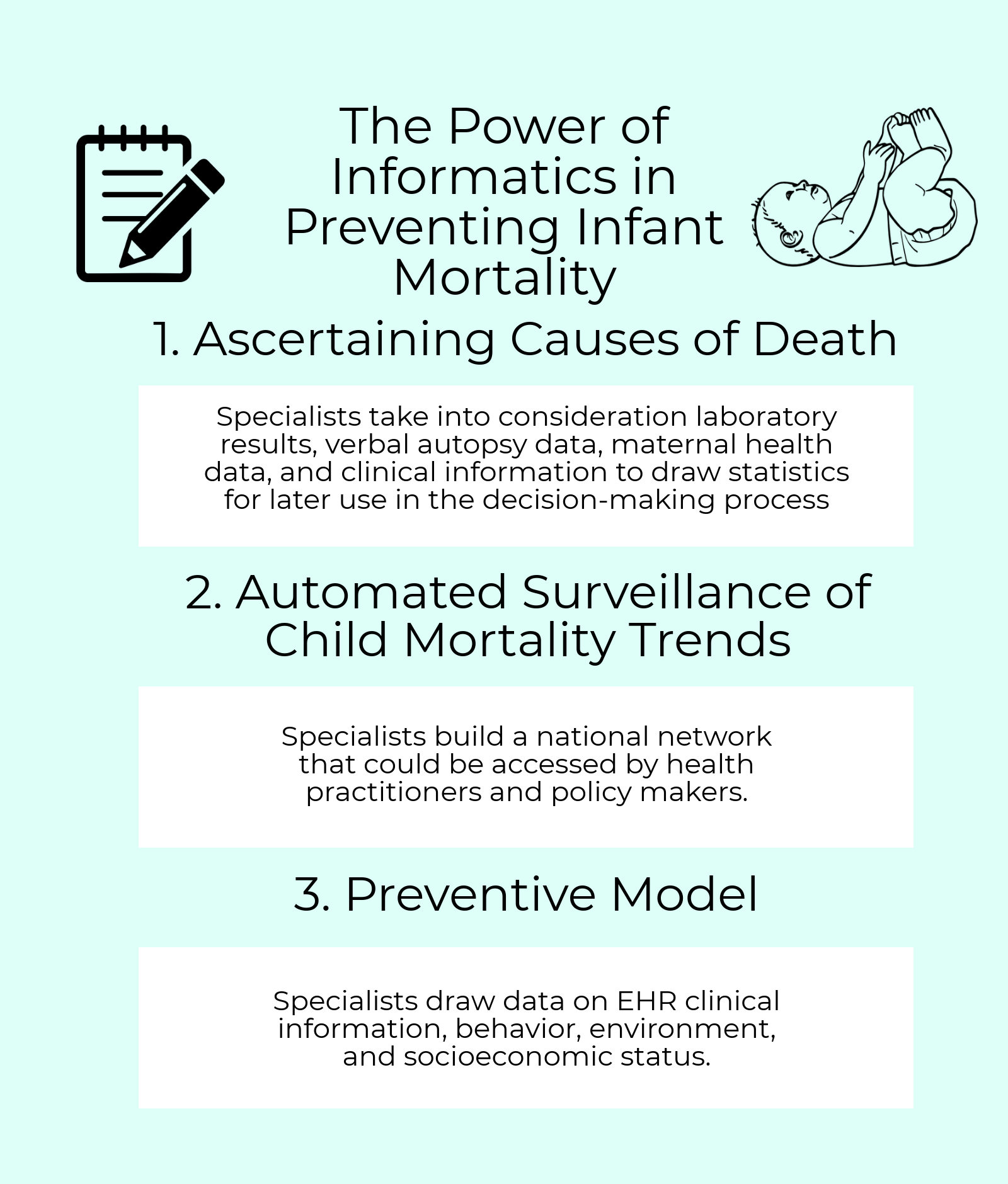
Among developed countries, the United States lags well behind with its 6 infant deaths per 1,000 live births. The five leading causes of infant mortality are congenital defects, preterm birth accompanied by low birth weight, pregnancy complications, injuries such as suffocation, and sudden infant death syndrome. This paper will discuss how informatics and manipulating big data can help women and health practitioners predict and prevent tragedy.
Ascertaining Causes of Death
The first step would be to determine prevailing definitive causes of infant death for a specific region, which would allow for a customized solution. A prime example of a campaign aiming at preventing infant mortality employing informatics is Child Health and Mortality Prevention Surveillance. CHAMPS Network takes place in Sub-Saharan Africa and Southern Asia. What makes CHAMPS approach unique is the scope of data that is being captured. Specialists take into consideration laboratory results, verbal autopsy data, maternal health data, and clinical information to draw statistics for later use in the decision-making process (Public Health Informatics Institute, 2016).
Automated Surveillance of Child Mortality Trends
The second step would be to develop a tool for automated surveillance of child mortality trends. It suffices not to evaluate the gravity of the issue locally; there is a need to build a national network that could be accessed by health practitioners and policymakers. Tourassi, Yoon, and Xu (2016) tested software that carries out online mining of obituaries to gather statistics on geospatial trends in cancer deaths. Even though the topic of the said study was not infant mortality, its objective is similar to that discussed in this paper.
Preventive Model
Lastly, once objective data has been drawn and awareness is raised, researchers need to come up with a preventive model that would heed all the relevant factors. Tsui (2017) offered four criteria for evaluating the likelihood of infant death. First, the model needs to analyze clinical EHR information which would coverage, race, preterm labor, birth defects, laboratory results, and other data. Second, each case should be put in the social context: parents’ education level, family environment, and bankruptcy. Lastly, behavioral data would include alcohol and drug abuse, whereas environmental data would deal with pollution, air and water quality, and so on.
Barriers and Challenges
Experts are confronted with several problems: they do not have appropriate tools for data collection that would cover all relevant domains and risk factors. The existing data is either insufficient, subjective, or includes only a handful of factors selected ad-hoc. Health care would benefit from implementing EHR (electronic health records) in every medical facility so that each organization could provide full information. The gathered evidence needs to be translated into practice, which, in the absence of a national strategy, might be challenging to say the least.
Conclusion
The death of a child is a tragedy for the parents, which, in some cases, could be prevented if the complications are predicted on time. Health care increasingly relies on informatics and new technologies, and there is a hope that they will be of use in decreasing infant mortality. A good strategy could include the following three steps: assigning causes of death, distributing and sharing data across an elaborate national network, and predicting negative outcomes.
References
Public Health Informatics Institute. (2016). Understanding childhood mortality through informatics. Web.
Tourassi, G., Yoon, H. J., & Xu, S. (2016). A novel web informatics approach for automated surveillance of cancer mortality trends. Journal of biomedical informatics, 61, 110–118.
Tsui, F. (2017). Using big data to predict infant mortality in Allegheny County, Pennsylvania. Web.